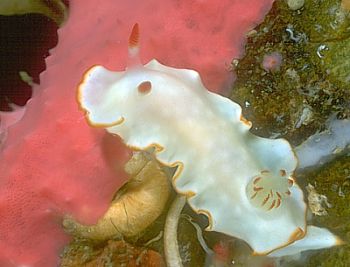
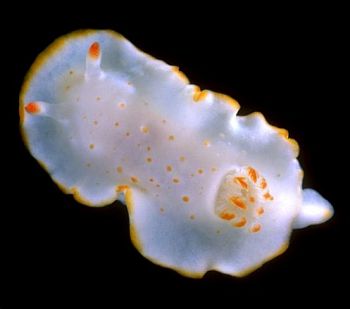
Diversidoris aurantionodulosa
Rudman, 1987
Order: NUDIBRANCHIA
Suborder: DORIDINA
Family: Chromodorididae
DISTRIBUTION
Records from Tanzania, eastern Australia and Hong Kong (Rudman 1987) suggest this species has a wide distribution in the tropical Indo-West Pacific
PHOTO
UPPER: On pink sponge (Darwinella sp) Coffs Harbour region, nthn New South Wales, Australia. December 1990, 20mm long. AM C164597.
LOWER: Bondi, Sydney New South Wales, October 1986, AM C151354. 15mm long. PHOTOS: Bill Rudman.
This recently described white species has a thin orange mantle border. The mantle is covered with low rounded tubercles which are often, but not always, tipped with orange. The rhinophores are white with orange tips and there is an orange line up the outside of each white gill. Can grow to 25 mm.
References:
• Rudman,W.B. (1987) The Chromodorididae (Opisthobranchia : Mollusca) of the Indo-West Pacific: Chromodoris epicuria, C. aureopurpurea, C. annulata, C. coi and Risbecia tryoni colour groups. Zoological Journal of the Linnean Society, 90: 305-407.
• Rudman, W.B. & Darvell, B.W. (1990) Opisthobranch molluscs of Hong Kong. Part 1. Goniodorididae, Onchidorididae, Triophidae, Gymnodorididae, Chromodorididae, (Nudibranchia). Asian Marine Biology, 7: 31-79.
Rudman, W.B., 2001 (August 22) Diversidoris aurantionodulosa Rudman, 1987. [In] Sea Slug Forum. Australian Museum, Sydney. Available from http://www.seaslugforum.net/find/diveaura
Related messages
Re: Diversidoris aurantionodulosa from Solomon Ids
December 12, 2008
From: Barbara Hanchard
Concerning message #22087:
Bill,
Just to confirm that this animal was indeed transiting over the sponge it was photographed on, as were the Honiara species we have sighted. They are so small and very active but your comments will make me vigilant if I do come across them stationary and possibly feeding on or near Semitaspongia sp or other sponges.
Regards,
Barbara
nbhanchard@gmail.com
Hanchard, N.B., 2008 (Dec 12) Re: Diversidoris aurantionodulosa from Solomon Ids. [Message in] Sea Slug Forum. Australian Museum, Sydney. Available from http://www.seaslugforum.net/find/22097Dear Barbara,
Thanks for the quick response. It can be tricky deciding if a potential food is really a food or just a footpath - especially as they walk over their food as well!
Best wishes,
Bill Rudman
Re: Diversidoris aurantionodulosa from Solomon Ids
December 12, 2008
From: Barbara Hanchard
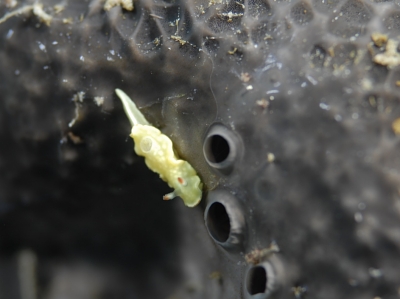
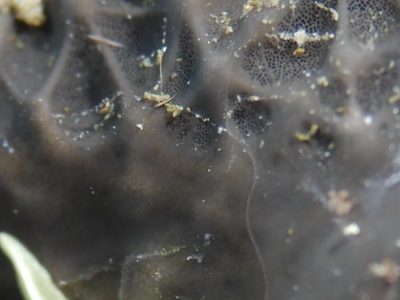
Concerning message #21914:
Bill,
Is this a colour variation of the same species. It's been in my files un-named until I noticed Tamara's message. This one was found in the same group of islands as Tam's entry but at the other end of the chain of islands.
Locality: Florida Islands, 15 meters, Solomon Islands, Pacific, 29 May 2008, coral head. Length: 4 mm. Photographer: N.Barbara Hanchard.
Barbara
barbara.hanchard@ffa.int
Hanchard, N.B., 2008 (Dec 12) Re: Diversidoris aurantionodulosa from Solomon Ids. [Message in] Sea Slug Forum. Australian Museum, Sydney. Available from http://www.seaslugforum.net/find/22087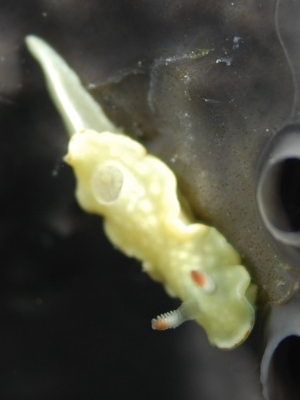
Dear Barbara,
Thanks for this. Yes it certainly looks as though it is Diversidoris aurantionodulosa. I guess the sparse orange pigmentation is due to the small size of the animal.
What is very interesting is the sponge the animal is crawling on. I realise it could just be passing over it, but it could also be its food sponge. The only information I have of the possible food of this species is an animal we found in eastern Australia on a pink species of Darwinella [see Fact Sheet]. As that Darwinella is the food choice of a number of species of Chromodoris and Noumea I have considered it to be the possible food choice of Diversidoris. However the grey sponge your animal is on is almost certainly a thorectid sponge (possibly Semitaspongia sp), and that group of sponges is the food choice of species of Glossodoris and some Chromodoris. Diversidoris has a puzzling mixture of anatomical characters, which make its relationship to other chromodorids difficult to determine. Finding out its actual food may give us a clue to its relatives.
Your photo doesn't answer the question, but it certainly is a warning to me not to feel too comfortable with Darwinella as its food choice. It would be great to get some more photos of this species, especially if there was a sponge involved.
Best wishes,
Bill Rudman
Diversidoris aurantionodulosa from Solomon Ids
September 30, 2008
From: Tamara Hartwich
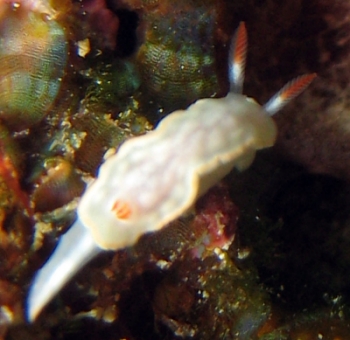
Dear Bill
I believe that this nudibranch is a Diversidoris aurantionodulosa. I thought I would send him in to add to the information you have on your website regarding its location. This juvenile was found on the weekend in Solomon Islands.
Locality: Coral Garden, Tanavula, 10 metres, Florida Islands, Solomon Islands, Pacific Ocean, 21 September 2008. Length: 10 mm. Photographer: Tamara Hartwich.
Tamara Hartwich
tamhartwich@yahoo.com.au
Hartwich, T.M., 2008 (Sep 30) Diversidoris aurantionodulosa from Solomon Ids. [Message in] Sea Slug Forum. Australian Museum, Sydney. Available from http://www.seaslugforum.net/find/21914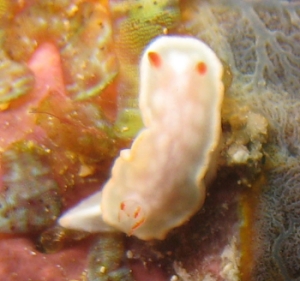
Dear Tamara,
Thanks for this interesting record. Although this species seem to be widespread throughout the tropical Indo-west Pacific. we don't have many records of it so every addition is valuable
Best wishes,
Bill Rudman
Diversidoris aurantionodulosa from South Africa
February 13, 2007
From: Colin Ogden
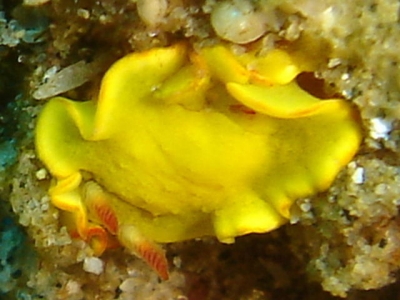
Hi Bill,
I have a nudi that I can't identify. Your help will be appreciated. It was very small so it may be a juvenile, but it does look like a Glossodoris to me.
Locality: Sodwana Bay, 14 metres, South Africa, Indian, 13 Jan 2007, coral reef. Length: 6 mm. Photographer: Colin Ogden.
Thanks a ton
regards
Colin
scubaco@iafrica.com
Ogden C. M., 2007 (Feb 13) Diversidoris aurantionodulosa from South Africa. [Message in] Sea Slug Forum. Australian Museum, Sydney. Available from http://www.seaslugforum.net/find/19433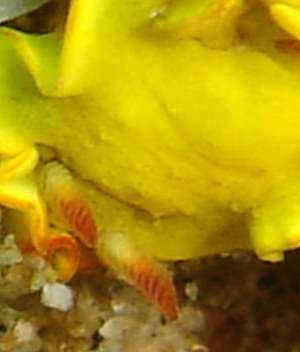
Dear Colin,
I am pretty sure this is Diversidoris aurantionodulosa. There are a couple of records of this species from Suth Africa with a yellow background colour. There are traces of orange around the mantle edge, and scattered mantle papillae, though not orange-tipped. The gills and rhinophores appear orange-tipped.
Best wishes,
Bill Rudman
Diversidoris aurantionodulosa from South Africa
March 10, 2006
From: Colin Ogden
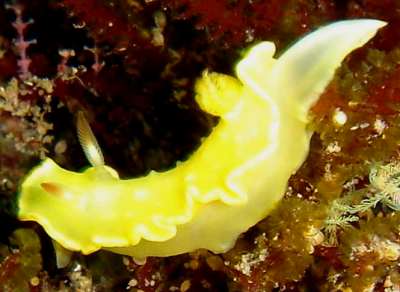
Hi Bill,
I need to bug you again about a nudi I can't ID. It reminds me of a Glossodoris pallida, but with the colours reversed, it appeared to be feeding, but my photos don't show evidence of this
Locality: Sodwana Bay, 16 m, South Africa, Indian, 24 Feb, coral reef. Length: 25mm. Photographer: Colin Ogden.
Thanks for you comments on the C. mandapamensis, and we will keep looking.
regards
Colin
scubaco@iafrica.com
Ogden C. M., 2006 (Mar 10) Diversidoris aurantionodulosa from South Africa. [Message in] Sea Slug Forum. Australian Museum, Sydney. Available from http://www.seaslugforum.net/find/16068Dear Colin,
Although it is yellow, I am pretty sure this is Diversidoris aurantionodulosa. The general shape and the papillae on the mantle are typical of the species, and I have found yellow examples like this in Australia.
Best wishes,
Bill Rudman
Diversidoris aurantionodulosa from South Africa
March 10, 2002
From: Valda Fraser
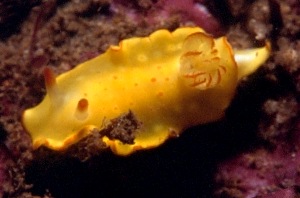
Dear Bill
I need help with identification. This yellow number has me confused. Could it be a Noumea? Thanks.
Locality: Pumula, south coast KwaZulu-Natal, South Africa, 30 m
Date: February 2002
Size: 12 mm
Regards
Valda Fraser
valdafraser@mweb.co.za
Fraser, V., 2002 (Mar 10) Diversidoris aurantionodulosa from South Africa. [Message in] Sea Slug Forum. Australian Museum, Sydney. Available from http://www.seaslugforum.net/find/6315Dear Valda,
This is Diversidoris aurantionodulosa. I first found it in Tanzania, but it seems to have a wide distribution, turning up here in Sydney now and then.
Best wishes,
Bill Rudman
Glossodoris averni ? from Bass Point (NSW)
August 23, 2001
From: Des Paroz
Hi Bill
Dived this morning (19 August 2001) at The Gutter, Bass Point (near Shellharbour, New South Wales). I spotted a small (20mm) nudi in about 15m or so and stopped to have a second look. It was sitting on rocky reef under the shade of some kelp fronds. My first thought was that it was a Glossodoris angasi, but on closer inspection, I realised that the colouration was wrong.
As I said, it was about 20mm in length, and looked like it was not fully developed (e.g. length of rhinopores out of proportion to body). It has a pure white body, with red-orange coloured gills and rhinopores. The edge of the mantle was a light purple coloured line all the way around.
Other than that it had no markings that I could determine. Looking at various books, the closest species I can see is a Glossodoris averni (which fits with my initial thoughts of it being a Glossodoris). However, I am really not sure, and it could easily have been a chromodorid. If it was a G. averni, it did not have the folds that are evident in Akos' photo, but as I said, I believe this one to have been a juvenile. Water temp was 18C.
I've tried to be as detailed as I could without the benefit of my camera (strobes are being serviced). Could this be a G. averni, or do you have any other thoughts? One other possibility is that it is Noumea simplex. has it been found in southern New South Wales?
Best regards
Des Paroz
des@paroz.com
Paroz, D., 2001 (Aug 23) Glossodoris averni ? from Bass Point (NSW). [Message in] Sea Slug Forum. Australian Museum, Sydney. Available from http://www.seaslugforum.net/find/5110Dear Des,
I must start by saying that it is very difficult identify an animal without a photo or a specimen. I can't think of anything that fits well. Orange rhinophores and gills and a purple mantle border are not a pattern that immediately springs to mind. Despite that it has given me the impetus to add another species to the Forum and improve the Glossodoris angasi page so I won't complain. I suggest G. angasi because the mantle border in that species ranges in colour from dark brown or black to a pale pinkish or orange-brown.
I have added information on Diversidoris aurantionodulosa because it has orange gills and rhinophores. It is another of the white chromodorids with yellow or orange borders.
Another possibility is Digidentis perplexa which has a purple border and orange markings on the gills and rhinophores. It does of course have orange marks on the mantle so doesn't really fit either. Basically without a photo or even a drawing I am lost.
Best wishes,
Bill Rudman
D. aurantionodulosa from Hong Kong
August 23, 2001
From: Bill Rudman & Brian Darvell
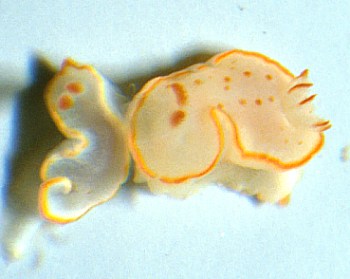
Here is some information and photos on Diversidoris aurantionodulosa from Brian Darvell's Hong Kong collections.
This recently described white species has a thin orange border and low rounded tubercles each tipped with orange. The rhinophores are white with orange tips and there is an orange line up the outside of each white gill. Can grow to 25 mm.
Hong Kong Collection Records:
AM C145666-7, 2 specimens, 3 February 1985, Site 9.159, 'Dolphin Reef', Rocky Harbour, 4 m. PHOTO: Brian Darvell.
Reference:
• Rudman, W.B. & Darvell, B.W. (1990) Opisthobranch molluscs of Hong Kong. Part 1. Goniodorididae, Onchidorididae, Triophidae, Gymnodorididae, Chromodorididae, (Nudibranchia). Asian Marine Biology, 7: 31-79
Best wishes,
Bill Rudman & Brian Darvell
Diversidoris aurantionodulosa from Tanzania
August 23, 2001
From: Bill Rudman
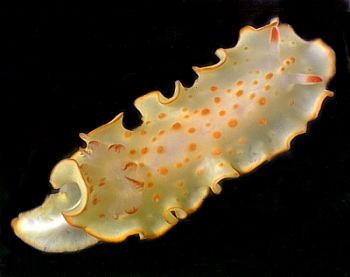
To accompany the other information I have just posted on this species, here is a photo of the Holotype of Diversidoris aurantionodulosa. I collected it in Dar es Salaam, Tanzania, from rich sponge growths on the main sewer pipe at the entrance to Dar es Salaam harbour. This was not a very sensible place to frequent because the sewer pipe had major leaks along its length as it ran across the raised limestone platform before disgorging its unsavoury untreated contents into the main channel. However the added nutrients enabled a lush growth of fouling organisms - including hydroids, bryozoans and sponges to flourish - and these attracted a wealth of interesting nudibranchs.
Data: Ocean Rd Beach, N side of harbour entrance, Dar es Salaam, Tanzania, 16 August 1973, Holotype, 25mm long (2 other specimens 4, 15mm long collected also). AM C.139457. Photo: Bill Rudman.
Best wishes,
Bill Rudman.
